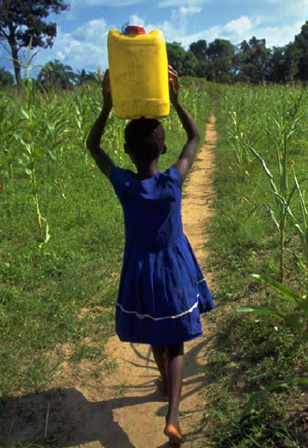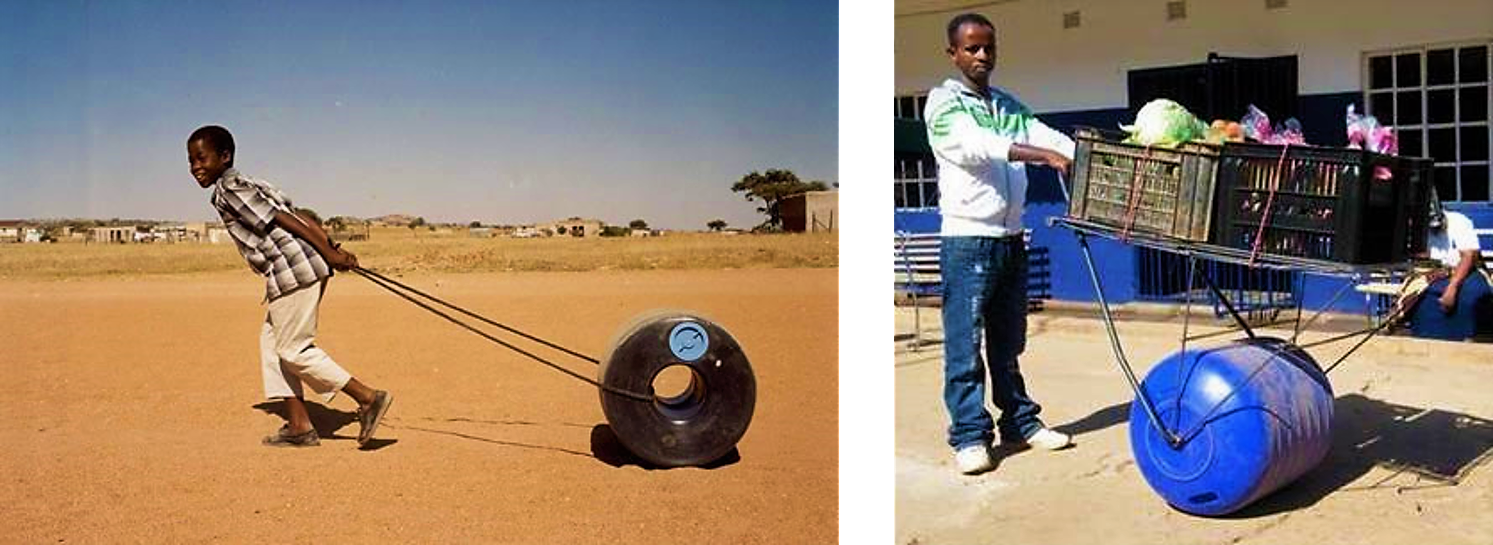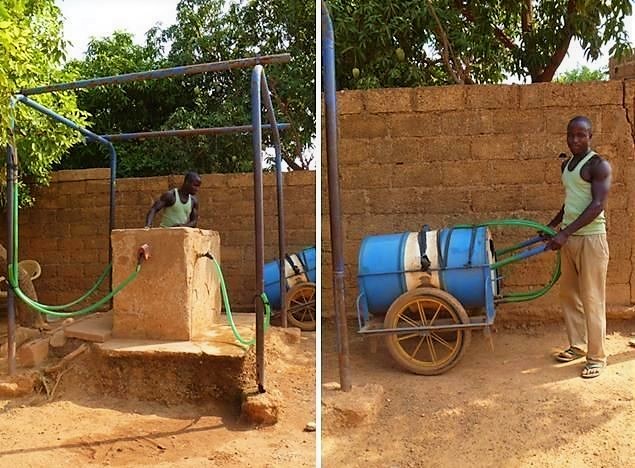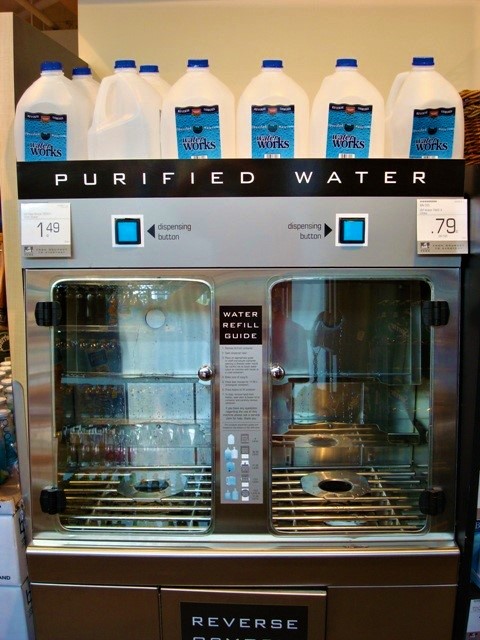Where there is no or not sufficient piped supply of freshwater and drinking water, nor any motorised vehicles to distribute it, water distribution needs to be human-powered. Human-powered water distribution refers to the use of jerry cans, buckets and small containers to fetch the water from a centralised distribution point (e.g. river, lake, borehole and well) and to transport it home. Either people collect and transport their water directly themselves, or they buy it from delivery vendors which often use small barrels on wheels to transport the water and to sell it door-to-door. In any case, the effort to collect water can be high for single families or communities and the price of bottled water is often higher than for a well-maintained public distribution system.
| Entradas | Salidas |
|---|---|
Freshwater, Drinking Water |
In many parts of the world people lack access to water for their daily needs (e.g. hygiene, drinking, cooking, cloth washing, etc.). In order to have a more easy access to water, people could try to help themselves by collecting rainwater for their families and communities (see also urban and rural rainwater harvesting and fog drip water harvesting), by installing shallow wells and a handpump, by getting water themselves walking long distances or by buying it from a mobile vendor. The manual method for water distribution via walking and mobile vendors is described below.
Long walk to get water
One solution to get fresh or drinking water where there is no piped supply or any motorised delivery, is to walk to a water source (well, lake, river, spring) and fill freshwater into containers such as buckets and bring it back. Besides the long walking distances and the time lost by women and children sent for fetching water (access to water and sanitation, water sanitation and development and the right to water and sanitation), the water sources are often unimproved and the risk of contamination either in the water source, in the return carriage (e.g. when dirty containers are used) or at the household level is frequent (see also waterborne diseases - pathogens and contaminants, water - sanitation and health and health risk management). In this case, household-level or point-of-use treatments and safe storage are crucial for the health and hygiene of the community (see also household water treatment and safe storage).

Rolling tanks
To make water transport easier for children and woman, there is the approach not to carry the water tanks but to roll these heavy tanks. Currently there are two very similar tanks on the market. The Q-Drum has a volume of 50 litres, is produced from durable plastic material and has a ‘donut shape’. A rope is tied through the central hole and the Q-Drum can be pulled by kids or women over a long distance and almost every terrain (QDRUM 2011; VEGAS 2011).
A very similar concept is the Hippo Water Roller. This water tank has a capacity of 90 litres and is manufactured from UV stabilised polyethylene and has been designed to withstand typical rural conditions. The sealed lid ensures hygienic storage of water and the steel handle provides firm control over difficult terrain while pulling or, in contrast to the Q-Drum, pushing the roller (HIPPOROLLER 2012).

Mobile water vendors
In many cities in the world, mainly in Africa, Asia and South America standpipe coverage and piped distribution is very low and vendors sell water door-to-door. They transport the water with water tankers, animal powered traction, human hand carters or water bearers (KEENER et al. 2009).

Mobile water vendors also get involved in periods of water shortages, such as emergencies or dry seasons. For instance during the dry season of 2009 in Ampara (Sri Lanka) each morning men on bicycles, with big barrels tied on their backs, travelled into the jungle to locate water springs and bring the water to populated areas (IRIN 2009).
Water jugs
In many countries, 20L water jugs or smaller reusable bottles are a very common way to transport water manually. In some areas, people just use them to fetch and transport the water. In other regions companies deliver them to the household. If they are used to transport water from a source or a distribution point (e.g. borehole or well) to the home, care should be taken to not pollute the water by using unhygienic jugs. If they are distributed and sold as an alternative to normal bottled water, empty jugs are replaced by the company by full ones which saves costs and avoids plastic waste (see also bottled water).

Costs depend widely on the context. In many urban areas or developed areas water in bottles and jugs are made available to most of the population. To fetch water and transport it from the source to the home can be time consuming and depending on circumstances could have an effect on the economic activity of the community. In any case, the price for water distributed by humans or trucks (see also motorised distribution) is often higher than the cost of having access to a well-maintained public distribution system.
The quality of the water depends a lot on the source of water (see table below). Its contents are not always of drinking water quality. Even if water is safe at the point of source, there is a high risk of contamination during transport. To prevent waterborne diseases from unverified sources, safe storage and treatment of the water at the point of use and adapted hygienic conditions are very important.
| Piped water into dwelling, plot or yard | Unprotected spring |
| Public tap or standpipe | Unprotected dug well |
| Tubewell or borehole | Small cart with tank/drum |
| Protected well | Tanker truck |
| Protected spring | Surface water (river, dam, lake, pond, stream, channel, irrigation channel) |
| Rainwater | |
| 1Bottled water is considered to be improved only when the household uses water from another improved source for cooking and personal hygiene; where this information is not available, bottled water is classified on a case-by-case basis. | |
Table 1: Improved and unimproved drinking water sources. Source: (WHO/UNICEF 2010)
| Working principle | Where no piped water distribution is available, water has to be transported either by trucks, animals or humans. Human-powered distribution utilises jugs and small containers up to human haulable barrels with wheels that are either fetched by the people themselves or by mobile vendors, which resell the water door-to-door. |
| Capacity/adequacy | Appropriate in all kinds of areas, but often time consuming and relatively expensive. |
| Performance | Depends on the applied technique. |
| Costs | Very low investment costs, but efforts for each acquisition can be high. |
| Self-help compatibility | Very high |
| O&M | Containers used for transport have to be cleaned properly before every use. |
| Reliability | Depending on the source. |
| Main strength | People can get their water themselves or buy it where they do not have piped access. |
| Main weakness | No control on the water quality and the source of the water, high risk of contamination, large expenditure of time and financial effort for each acquisition |
Human-powered distribution can be done everywhere where water is available in walking distance by people who have both the need and time for transporting it. The water can be for their own use or to be sold door-to-door.
Hippo Water Roller Project
Sri Lanka: Water Shortages Grip Southeast
Provision of Water to the Poor in Africa. Experience with Water Standposts and the Informal Water Sector
This paper reviews recent literature and available data on standpipes and the informal water sector in Sub-Saharan Africa. It identifies gaps in the research and outlines recommendations for additional research on water provision for the poor.
KEENER, S., LUENGO, M. and BANERJEE, S. (2010): Provision of Water to the Poor in Africa. Experience with Water Standposts and the Informal Water Sector. Washington, DC: The World Bank URL [Visita: 22.03.2019] PDFThe Rollable Water Container for Developing Countries
Brilliant Eco Inventions: Big Ideas, Small Packages
A Snapshot of Drinking Water and Sanitation in Africa. A regional perspective based on new data from the WHO/UNICEF Joint Monitoring Programme for Water Supply and Sanitation
This document contains a new set of drinking water and sanitation coverage estimates for Africa based on the most recent JMP (Joint Monitoring Programme for Water Supply and Sanitation) estimates (2006). It provides an assessment of the population currently using an improved drinking-water source and basic sanitation, disaggregated by sub-regions and urban and rural areas. It further details African progress towards the Millennium Development Goal (MDG) target for drinking-water supply and sanitation (Target 7c).
UNICEF ; WHO (2008): A Snapshot of Drinking Water and Sanitation in Africa. A regional perspective based on new data from the WHO/UNICEF Joint Monitoring Programme for Water Supply and Sanitation. New York and Geneva: UNICEF and World Health Organisation (WHO) URL [Visita: 16.05.2019]Progress on Sanitation and Drinking-Water. 2010 Update
This well illustrated report describes the status and trends with respect to the use of safe drinking-water and basic sanitation, and progress made towards the MDG drinking-water and sanitation target. It presents some striking disparities: the gap between progress in providing access to drinking-water versus sanitation; the divide between urban and rural populations in terms of the services provided; differences in the way different regions are performing, bearing in mind that they started from different baselines; and disparities between different socioeconomic strata in society. Each JMP report assesses the situation and trends anew and so this JMP report supersedes previous reports (e.g. from 2004, 2006 and 2008).
WHO ; UNICEF (2010): Progress on Sanitation and Drinking-Water. 2010 Update. Geneva: World Health Organisation (WHO) / New York: UNICEF URL [Visita: 16.05.2019]Q Drum: Water Transportation Made Easier
A Snapshot of Drinking Water and Sanitation in Africa – 2010 Update. A Regional Perspective Based on New Data from the WHO/UNICEF JMP for Water Supply and Sanitation
This Snapshot of Drinking Water and Sanitation in Africa (2010 update) aims at informing on the status and trends in progress towards achieving the MDG drinking-water and sanitation target in Africa. It includes statistics, illustrations, tables and graphics specifically related to the African continent, based on the JMP 2010 report data and prepared in collaboration with the WHO/UNICEF JMP.
AFRICAN MINISTERS’ COUNCIL ON WATER (AMCOW) (2010): A Snapshot of Drinking Water and Sanitation in Africa – 2010 Update. A Regional Perspective Based on New Data from the WHO/UNICEF JMP for Water Supply and Sanitation. Abuja: African Ministers’ Council on Water URL [Visita: 16.05.2019]Sick Water? The central role of wastewater management in sustainable development
This book not only identifies the threats to human and ecological health that water pollution has and highlights the consequences of inaction, but also presents opportunities, where appropriate policy and management responses over the short and longer term can trigger employment, support livelihoods, boost public and ecosystem health and contribute to more intelligent water management.
CORCORAN, E. ; NELLEMANN, C. ; BAKER, E. ; BOS, R. ; OSBORN, D. ; SAVELLI, H. (2010): Sick Water? The central role of wastewater management in sustainable development. A Rapid Response Assessment. United Nations Environment Programme (UNEP), UN-HABITAT, GRID-Arendal URL [Visita: 05.05.2010] PDFProvision of Water to the Poor in Africa. Experience with Water Standposts and the Informal Water Sector
This paper reviews recent literature and available data on standpipes and the informal water sector in Sub-Saharan Africa. It identifies gaps in the research and outlines recommendations for additional research on water provision for the poor.
KEENER, S., LUENGO, M. and BANERJEE, S. (2010): Provision of Water to the Poor in Africa. Experience with Water Standposts and the Informal Water Sector. Washington, DC: The World Bank URL [Visita: 22.03.2019] PDFA Snapshot of Drinking Water and Sanitation in Africa. A regional perspective based on new data from the WHO/UNICEF Joint Monitoring Programme for Water Supply and Sanitation
This document contains a new set of drinking water and sanitation coverage estimates for Africa based on the most recent JMP (Joint Monitoring Programme for Water Supply and Sanitation) estimates (2006). It provides an assessment of the population currently using an improved drinking-water source and basic sanitation, disaggregated by sub-regions and urban and rural areas. It further details African progress towards the Millennium Development Goal (MDG) target for drinking-water supply and sanitation (Target 7c).
UNICEF ; WHO (2008): A Snapshot of Drinking Water and Sanitation in Africa. A regional perspective based on new data from the WHO/UNICEF Joint Monitoring Programme for Water Supply and Sanitation. New York and Geneva: UNICEF and World Health Organisation (WHO) URL [Visita: 16.05.2019]Progress on Sanitation and Drinking-Water. 2010 Update
This well illustrated report describes the status and trends with respect to the use of safe drinking-water and basic sanitation, and progress made towards the MDG drinking-water and sanitation target. It presents some striking disparities: the gap between progress in providing access to drinking-water versus sanitation; the divide between urban and rural populations in terms of the services provided; differences in the way different regions are performing, bearing in mind that they started from different baselines; and disparities between different socioeconomic strata in society. Each JMP report assesses the situation and trends anew and so this JMP report supersedes previous reports (e.g. from 2004, 2006 and 2008).
WHO ; UNICEF (2010): Progress on Sanitation and Drinking-Water. 2010 Update. Geneva: World Health Organisation (WHO) / New York: UNICEF URL [Visita: 16.05.2019]SODIS - Water Quality Improvement at Household Level. A Case Example From the Kibera Slum, Nairobi, Kenya
This document outlines that the drinking water sources in the Kibera Slum in Nairobi are of very bad condition. It contains information about Kenya Water for Health Organization (KWAHO) and its implementation of a Solar Water Disinfection (SODIS) project.
KWAHO (n.y): SODIS - Water Quality Improvement at Household Level. A Case Example From the Kibera Slum, Nairobi, Kenya. Nairobi: EAWAG / SANDEC URL [Visita: 16.05.2019]Hippo Water Rollers in South Sudan
This is a report to evaluate what impact the Hippo Water Rollers had made on the community of Maleng-Agok (South Sudan) after 8 months of use.
HIPPOROLLER (2010): Hippo Water Rollers in South Sudan. Johannesburg: The Hippo Water Roller Project URL [Visita: 16.05.2019]Water shortages grip southeast
In this web article, it is described how mobile vendors sold water during a water shortage in Ampara District, Sri Lanka.

